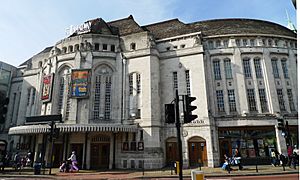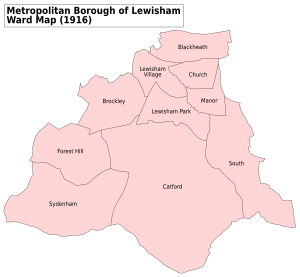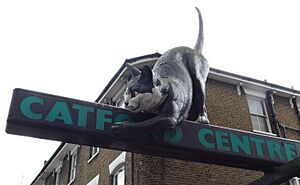Catford facts for kids
Catford is a lively area in southeast London, England. It's like the main office for the London Borough of Lewisham, where many important decisions are made. Catford is southwest of Lewisham and is home to about 44,905 people (as of 2011), including the nearby area of Bellingham. Most of Catford is within the SE6 postcode district. It's also recognized as one of the 35 most important centers in Greater London.
Quick facts for kids Catford |
|
|---|---|
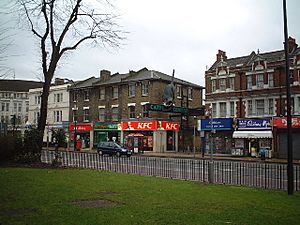 The Catford Cat, a giant fibreglass sculpture of a black cat above the entrance to the Catford Centre, with the Village Green and Water Pump shown in the foreground |
|
| Population | 44,905 (2011 Census) |
| OS grid reference | TQ385735 |
| London borough | |
| Ceremonial county | Greater London |
| Region | |
| Country | England |
| Sovereign state | United Kingdom |
| Post town | LONDON |
| Postcode district | SE6 |
| Dialling code | 020 |
| Police | Metropolitan |
| Fire | London |
| Ambulance | London |
| EU Parliament | London |
| UK Parliament |
|
| London Assembly |
|
Contents
Catford's Story: Past and Present
What's in a Name?
No one is completely sure how Catford got its name! Some people think it comes from a time when cattle (cows) used to cross the river Ravensbourne here. Others believe it might be because wild cats used the river crossing a long time ago.
How Catford is Governed
Catford is part of the London Borough of Lewisham. It has two main areas, called wards: Rushey Green and Catford South. It also makes up a big part of the Lewisham East area, which has a representative in the UK Parliament.
Exploring Catford's Buildings
Old and New Buildings
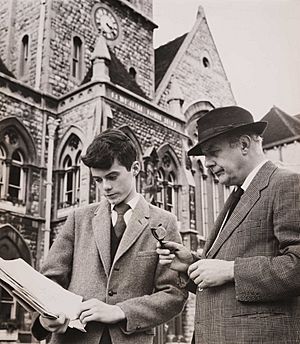
Catford has some cool buildings! The Broadway Theatre is an amazing art deco building from 1932. It has a curved stone design and a green spire. It's now a Grade II listed building, which means it's protected because of its special history and design.
There's also a big, old-fashioned police station that looks like a castle! In 2006, a large blue pipe sculpture was put up outside Eros House. This building used to be a cinema and a theatre called the Lewisham Hippodrome.
In the 1960s and 70s, Catford's look changed a lot. The old Lewisham Town Hall from 1875 was replaced by the modern Civic Suite in 1968. Laurence House, where many of the Lewisham Council offices are, stands where the old St Laurence's Church used to be. The original church was moved to a more modern building nearby in 1968.
You can still see an old village water pump from the 1850s in Rushey Green. After World War II, many temporary homes called "prefabs" were built in the Excalibur Estate in Catford. Most of these are being replaced with new homes, but six of them are protected because they are so historic.
Unique Architecture
Some buildings in Catford show a style called "Brutalist architecture." This style uses lots of raw concrete. The Catford shopping centre and Milford Towers, designed by Owen Luder in 1974, are examples. The idea was to make Milford Towers like a "Barbican of the south," referring to a famous London housing estate.
A famous critic, Ian Nairn, once said that Eros House (another building by Owen Luder from 1962) was "just what the place needed." He liked its strong concrete look and how it fit into the area. Milford Towers was planned for demolition, but it was refurbished in 2018.
Famous Catford Sights
One of Catford's most famous sights is the Catford Cat! It's a giant fibreglass sculpture of a black cat. You can see it above the entrance to the Catford centre. It looks like the cat is clawing at the sign! There's also a busy street market on Catford Broadway.
From 1932 to 2003, Catford Stadium was a popular place for greyhound racing. Sadly, it closed and was later destroyed by fire in 2005. New homes are now built there.
Catford's oldest pub is The Ninth Life (it used to be called the Black Horse and Harrow). The Catford Bridge Tavern is another historic building near the old dog track. It burned down in 2015 but has been rebuilt and reopened. Nearby, you'll find St Dunstan's College.
Catford also used to have film studios in the silent era and a cinema.
Catford's Future: Regeneration Plans
Catford town centre is a very important area for new developments in the London Borough of Lewisham. Several key places, like Milford Towers, Catford Island, and the Civic Centre, are planned for big changes.
The council hopes to completely rebuild the Catford Shopping Centre and Milford Towers. This would mean taking down the current buildings and car parks. However, these plans can be tricky because of money and the many different landowners involved.
Getting Around Catford
Train Stations
Catford has two train stations: Catford and Catford Bridge.
- Catford station has Thameslink trains that go to places like Kentish Town, London Blackfriars, and Orpington.
- Catford Bridge station has Southeastern trains that go to London Charing Cross, London Cannon Street, and Hayes.
Bus Services
Many Transport for London bus routes serve Catford, making it easy to travel around.
Main Roads
Catford's main road is the A205 South Circular. This road goes across South London, from Woolwich in the east to Gunnersbury in the west.
Future Transport Ideas
Bakerloo Line Extension
There are ideas to extend the Bakerloo Underground line from Lewisham. In the future, it might even reach Catford and Hayes! No final decisions have been made yet.
Docklands Light Railway Extension
Transport for London (TfL) is also thinking about extending the Docklands Light Railway (DLR) from Lewisham to Bromley. The first part of this extension could be from Lewisham to Catford. Lewisham Council has suggested that any new DLR route should be underground to avoid affecting the look of the area.
Learning and Green Spaces
Schools in Catford
Catford has several schools:
- The local council runs Conisborough College and Greenvale School.
- There are also two independent schools: St Dunstan's College and a small faith school called Springfield Christian School.
Parks and Green Areas
River Pool Linear Park
This park follows the River Pool, which stays above ground for most of its journey. The riverbanks have been planted with native trees, shrubs, and wildflowers. It's part of the Waterlink Way, a walking and cycling route that follows the river from Sydenham to the Thames.
Mountsfield Park
This large park is where Charlton Athletic F.C. used to play football in the 1920s. The local council holds its big annual "People's Day" event here every July.
Ladywell Fields
This park has three fields with a river flowing through them. It's right next to University Hospital Lewisham. One special thing about the middle field is that it has one of the last rare Dutch Elm trees in London.
Iona Close Orchard
Iona Close Orchard is a preserved Victorian garden. Old orchards like this are very important for nature and wildlife. The houses it originally belonged to were built around 1825.
Sports in Catford
Sports Facilities
The Jubilee Ground, which is 20 acres big, is run by St Dunstan's College. Catford Stadium was a famous place for greyhound racing and also hosted boxing matches until it closed in 2005.
Local Sports Teams
Catford has a local football club called Lewisham Borough F.C. They play at the Ladywell Arena. The Kent County Cricket Club has played in Catford many times in the past. The Catford Cycling Club was started way back in 1886! They even built their own track in 1894. The club is still active today.
Famous People from Catford
Many interesting people have connections to Catford:
- Jak Airport, guitarist for the punk band X-Ray Spex.
- Ray BLK, a British singer and songwriter.
- Captain William Colbeck (seaman), an Antarctic explorer.
- Henry Cooper, a famous British heavyweight boxer.
- Ernest Christopher Dowson, a poet who created the phrases 'Days of wine and roses' and 'Gone with the wind'.
- Leslie Dwyer, an actor.
- Ben Elton, a well-known comedian and writer.
- Joe Gomez, a defender for Liverpool F.C..
- The band Japan (band) (including David Sylvian, Mick Karn, Steve Jansen, and Richard Barbieri) grew up here.
- Jem Karacan, an international footballer.
- Lucy Mangan, a columnist for The Guardian newspaper.
- Andy McNab, a former soldier and writer.
- Alexander McQueen, a famous fashion designer.
- Jacqui McShee, a folk singer.
- Spike Milligan, a comedian and writer, went to school in Catford.
- Frank Pullen, a property developer.
- Bernard Sunley, a property developer and giver to charity.
- Robin Trower, a guitarist.
- Robert Stanford Tuck, a Second World War fighter pilot.
- Chris Welch, a music journalist.
Catford's Location
 |
Honor Oak | Ladywell | Hither Green |  |
| Forest Hill | Lee | |||
| Sydenham | Bellingham | Southend |
Other Nearby Areas
- Lewisham
- Brockley
- Ladywell
- Bellingham, London
- Downham
- Grove Park
- Lee, London
- Sydenham
- Forest Hill
- Beckenham
- Bromley
- Peckham
Images for kids



